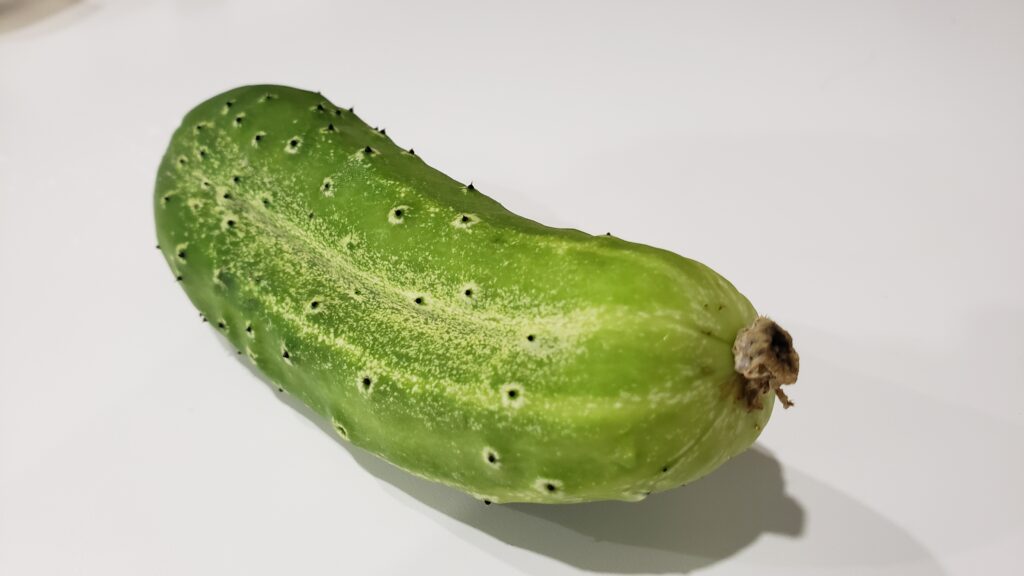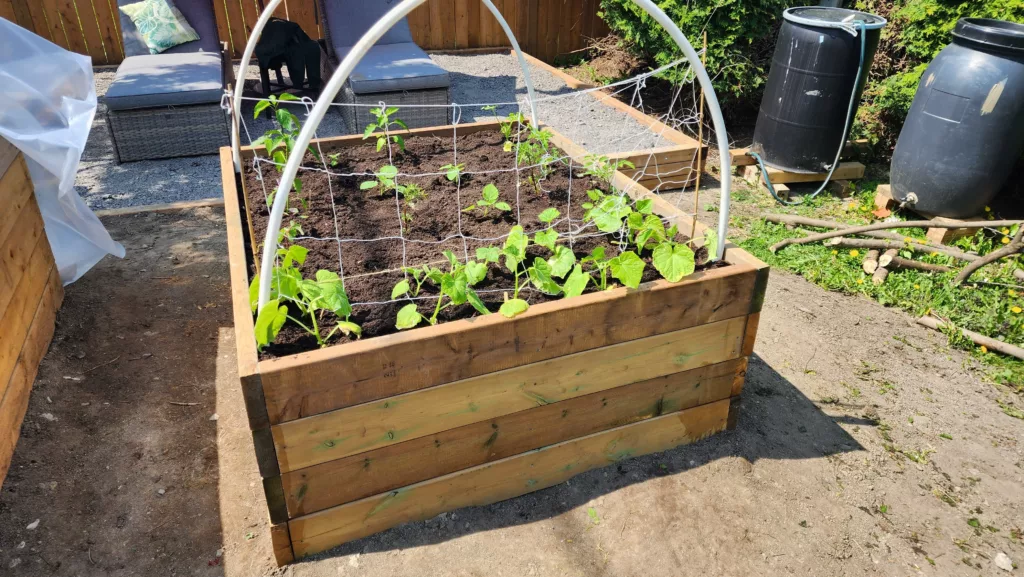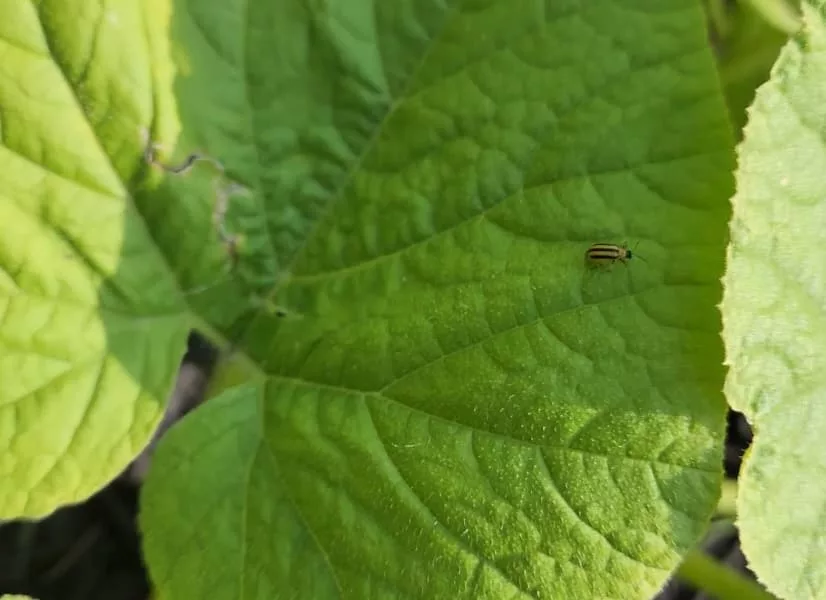Cucumbers are a great plant to grow from seed because they are quick to mature, produce a lot of fruit, and come in varieties that you can’t access from the grocery store, making them a fun plant to grow.
A Quick Summary
Cucumbers are a heat-loving, vining plant that can produce all through the summer. Cucumbers like to grow vertically on trellises, require pollination to set fruit, and fruit prolifically. They taste delicious raw or pickled!
Varieties

There are a wide variety of cucumbers on the market, from the english cucumber found in grocery stores, to pickling varieties such as Chicago (our personal favourite & pictured above). There are varieties that are white or yellow, as well as egg shaped cucumbers. When choosing the best variety for you, make sure that the days to maturity fits your growing zone, and avoid hybrid (F1) varieties if you wish to save seeds.
Sun Requirements
Cucumbers require full sun. The more sun, the better they will grow and produce.
Soil Preferences
Cucumbers need rich, well-draining soil. Because of how quickly they grow, they require a lot of nutrition so make sure to fertilize them regularly.
Join the newsletter to get more great advice straight to your inbox!
How to Plant Cucumber Seeds
Cucumbers have a quick days to maturity so you can plant your cucumbers directly in the garden after all danger of frost has passed and the soil has warmed. Your other option is to start them indoors. If you choose to start them indoors, start 4 weeks before your last frost date as they are quick growers. Since cucumbers grow vertically, you don’t want them to grow so large that you have to support them indoors.
Plant the seeds at a depth that is 2x the seed size (for example, if the seed is 1mm, plant it 2mm below the soil level). If you are unsure on how to plant the seeds, you can check out our comprehensive seed starting guide that will answer all of your seed questions, including which side to plant downward.
Caring for Cucumber Seedlings



Cucumbers are quick growers that require a lot of nutrition, so it’s important to not start them too early. If your cucumbers have outgrown their pot, upgrade them to a larger pot to avoid stunting the plants.
If your plant starts developing flowers indoors, pinch them off, and upgrade to a larger pot (if you haven’t already done so recently). You want your seedling to put its energy into root growth and not producing fruit.
Leading up to your last frost date, if the days are warm, start bringing your plants out to harden them off. If you are not sure how to do so, you can check out our guide here which covers the hardening off process.
Continue your garden learning:
- How to Protect Your Plants from Cucumber Beetles
- How to Grow Cucumbers From Seed to Harvest
- What the Calgary Water Main Break Can Teach Us In Our Gardens
- Drowning in Kale? Here are 9 Ways to Use Your Harvest!
- How to Grow Bush Beans from Seed to Harvest
Planting Guide

Cucumbers can be planted outdoors once all danger of frost has passed. Make sure that the nights don’t drop below 10°C as cucumbers don’t like cold temperatures. Plant them near a trellis, obelisk or any structure that they can climb. Because they like warm temperatures and full sun, make sure you plant them in a sunny location.
If your plant has any blooms on it, pinch them off to promote root growth to allow the plant to grow stronger (see centre and right photos above where the bloom was, and now isn’t). Water every day for the first week and then reduce watering to every few days after.
Watering
Cucumbers require a lot of water to grow since the fruit is mostly comprised of water. Regular waterings in the summer is important for proper fruit growth.
Harvesting

Cucumbers have male and female flowers, so in order to get fruit you need to have both blooms on your plant at the same time. If you aren’t getting cucumbers, check that both flowers are open around the same time. The easiest way to identify the difference is that female flowers have a miniature cucumber on the back of the flower.
If you notice there are blooms open and you don’t see any pollinators around, you can hand pollinate the flowers to guarantee fruiting. To do this, pick a male flower off the plant, and peel the petals off, leaving just the centre of the flower (the stamen). Rub the stamen on the inside of a female flower and now it has been pollinated!
Generally this isn’t an issue with cucumbers, and tends to affect zucchini more often, however having this knowledge can help guarantee a cucumber harvest in your future.
It’s very important to harvest cucumbers regularly. As soon as a cucumber has grown to it’s full size, it’s important to pick it and not wait any longer. When cucumbers are left on the vine, it signals to the plant to stop producing fruit as it is now going to seed, and you won’t get any more cucumbers from that plant.
Maintenance
Cucumbers need regular pruning to allow airflow through the plant and to allow pollinators easier access to the blooms. You can prune 1/3 of the leaves off the cucumber and it will still continue growing, so don’t be shy to cut off leaves. Without proper airflow, cucumber plants are susceptible to disease.
Ways to Enjoy Cucumbers

Cucumbers are delicious fresh in salads, sliced with a hummus dip and also pickled into.. pickles! We grow cucumbers primarily to pickle because they last all year long and save money on groceries. If you also wish to pickle, make sure you grow a pickling variety as the salad varieties will be mushier and less crunchy than a pickle variety.
Join the family, get advice straight to your inbox!
Common Pests & Problems

Cucumber plants can be divas. They can be difficult to grow without the right light, but there’s also a few issues that can affect cucumber plants, including cucumber beetles (striped and spotted), bacterial wilt and powdery mildew, to name a few. We are going to cover the three listed above, however if you want to learn about other potential issues, you can check out this article from the University of Maryland.
For all three of the issues mentioned above, pruning your plants and keeping good airflow will help with the prevention of the fungal or bacterial issues, and help to catch the insects.
Cucumber Beetles
Cucumber beetles are a gardeners nemesis. The main beetle that we get is the striped cucumber beetle (see photo above), and when they find your garden they will come in the HUNDREDS. They fly quickly, come in large quantities and will take over your plants overnight. They are attracted to any plants that are cucurbits such as cucumbers, zucchini, melons, or squashes, however they prefer cucumber plants the most.
The beetles eat the leaves and flowers of the plant leaving them unable to pollinate, robbing you of any harvest. Although they are attracted to melons, squashes and zucchini, they do the most damage on cucumber plants. Because cucumber flowers are so small, it doesn’t take long for the flower to be so damaged it loses any chance of pollination. When checking for beetles look inside closed flowers, under leaves and flying around.
Bacterial Wilt
Bacterial wilt is primarily caused by striped cucumber beetles who transport the bacteria into the cucumber plant. When plants get bacterial wilt, you will first notice one or two leaves look wilted, as if the plant needs water. Slowly it will transition to the entire plant where it becomes fully wilted, as if it is desperate for water or dead. Unfortunately, there is nothing you can do to save the plant once it gets infected, so you have to pull it out and dispose of it.
Powdery Mildew
Powdery mildew is a fungal pathogen that causes your plant leaves to be covered in a white powder. As soon as you notice this on your plants, prune the infected leaves right away. Clean your pruners after you’re done. If you keep on top of pruning the infected leaves you can slow the progression. However, often this can kill your plants, so if you have time in the season to start new plants, it would be a good decision.
Saving Seeds

Saving seeds is possible with cucumbers as long as you’re not growing a hybrid variety and your plant is healthy at the time of harvest. If you wish to save seeds, we recommend waiting until the end of the season, so your plant won’t stop producing fruit. Also, if you’ re growing multiple cucumber varieties, or other plants from the Cucurbit family (such as pumpkin, loofah or zucchini) the plants can cross pollinate, leaving you with a different variety when you grow the seeds next season.
To save cucumber seeds, leave a cucumber on the plant to grow as large as possible. When you notice that the fruit has stopped growing in size, and the skin has thickened and changed to a yellow or orange colour, you can pick the fruit.
Similar to saving tomato seeds, cucumber seeds need to be fermented in water to remove the gel around the seed. Place the seeds in a lidded container, filled with water. Leave the container on the counter for 3-4 days, shaking it once a day. On the 4th day, pour the water and seeds into a strainer to allow the water to pass through, but catching the seeds. If the seeds no longer have the gel surrounding them, lay them on a plate to dry, turning them once to avoid them sticking to the plate. If the gel is still on the seeds, put them back in the container with fresh water, and leave for a few days before repeating this process.
Once the seeds are dry, store them in a cool, dry place over winter.









